Medicare Pays Medicare Advantage Plans 6% More Than FFS Medicare
Medicare Advantage plans have seen growing enrollment in recent years, but they have also seen persistent coding intensity problems that lead to excess payments.

Source: Getty Images
- Medicare Advantage enrollment as a share of overall Medicare enrollment continued to rise in 2022, but payment inequity calls for serious reforms, according to a presentation from MedPAC.
The Medicare Advantage status report showed that Medicare Advantage beneficiaries accounted for 49 percent of Medicare enrollment in 2022, up from 46 percent in the year prior. Since 2016, Medicare Advantage plans’ share of enrollment has grown from a third of all Medicare beneficiaries to nearly half.
As in past years, health maintenance organizations (HMOs) dominated the Medicare Advantage enrollment landscape.
However, local preferred provider organizations (PPOs) have also seen growth. In 2017. 5.0 million beneficiaries were enrolled in Medicare Advantage local PPOs and 12.1 million were enrolled in HMOs. In 2022, local PPOs have 11.2 million enrollees and HMOs have 17.1 million. Thus, while HMOs held the highest share of the beneficiary population, local PPOs saw greater numerical growth.
Nearly every Medicare Advantage beneficiary in 2023 has access to a Medicare Advantage plan and 99 percent have access to zero-premium plans with Medicare Part D coverage. The average Medicare beneficiary can pick from 41 plan options.
While Medicare Advantage plans have seen significant gains in enrollment, experts called out the program’s excess payments.
The average monthly rebate per enrollee rose from $89 per enrollee in 2017 and more than doubled to $196 per enrollee in 2023. Alongside this upward trajectory, rebates as a percent of payment steadily rose from 10 percent in 2017 and 2018 to 17 percent in 2023.
Although 2023 Medicare Advantage bids were lower than in previous years, 2023 Medicare Advantage payments exceed fee-for-service Medicare payments. Medicare Advantage bids were 90 percent of fee-for-service in 2017 and 2018 but gradually declined to 83 percent of bids in 2023. Meanwhile, payments relative to fee-for-service have oscillated between 100 percent and 101 percent since 2017.
This remained true even when MedPAC did a prospective and retrospective comparison of Medicare Advantage payments and fee-for-service spending in 2017, 2018, and 2019.
In all three years, Medicare Advantage payments amounted to 100 percent or 101 percent of fee-for-service spending and when MedPAC accounted for coding difference this increased to 103 percent, 102 percent, and 104 percent of fee-for-service spending in 2017, 2018, and 2019 respectively.
Medicare Advantage plans continue to code more diagnoses than fee-for-service Medicare. This trend has worsened over the last five years.
In 2018, Medicare Advantage plans’ risk scores were 8.2 percent higher than fee-for-service Medicare and Medicare Advantage coding had a 2.3 percent impact on payment. In 2021, Medicare Advantage plans coded 10.8 percent higher than fee-for-service and the impact of Medicare Advantage coding rose to 4.9 percent.
“Between 2007 and 2023, MA coding intensity generated nearly $124 billion in excess payments,” the MedPAC researchers found.
The eight largest Medicare Advantage organizations that cover over three-fourths of Medicare Advantage enrollees had a coding intensity variation of 9 percentage points. The majority of organizations responsible for high coding were located in California or Florida.
MedPAC experts reminded readers that the organization had already issued its recommendations for improving Medicare Advantage coding intensity, benchmarks, and more.
A separate study from the Urban Institute found that Medicare Advantage’s structural issues lead to overpayment.
